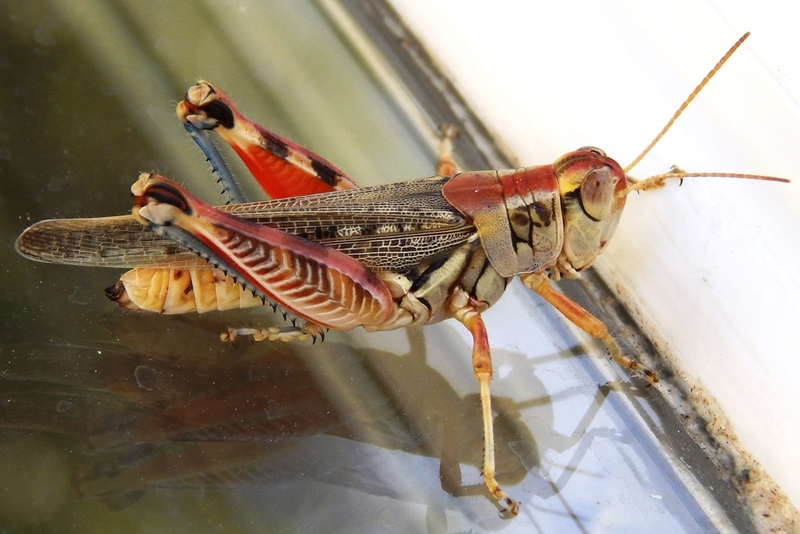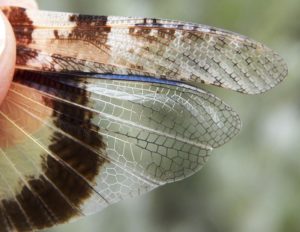
Photo: Salvador Vitanza
Most recently reviewed by: Ed Bynum (2018)
Common Name(s): Differential Grasshopper, Grasshoppers, lubber grasshopper, migratory grasshopper, Packard grasshopper, red-legged grasshopper, two-striped grasshopper
Description
Grasshoppers undergo gradual metamorphosis as the nymphs (immature insects) molt to the next growth stage. This means that nymphs look very much like adults, except that the nymphs do not have fully developed wings. If a grasshopper’s wings are fully developed, then it is an adult. The long hind pair of legs is well adapted for jumping, and adults are good fliers over short distances.
There are many color variations according to species, and many species are well camouflaged and difficult to see unless they move. Other species are brightly colored.
All grasshoppers have mandibles (teeth) and damage plants by chewing chunks of tissue from leaves and other plant parts. The feeding usually begins on outside edges of leaves and the chewed area has ragged or irregular edges. This often looks quite different from the smoother, more even damage done by caterpillars.
- Aztec spur-throat grasshopper nymph showing lack of developed wings. Photo by Salvador Vitanza
- Pallid-winged grasshopper front and hind wings
- Typical grasshopper feeding damage that begins on the outside edges of leaves. Photo by Pat Porter.
Origin and Distribution
Grasshoppers are distributed worldwide and occasionally reach serious pest outbreak status causing major crop loss. Occasionally, large flights of grasshoppers are detected on radar.
Habitat & Hosts
Almost any type of plant including corn, alfalfa, Bermudagrass, cotton, millet, peanut, rice, ryegrass, sorghum, Sudangrass, soybean, sugarcane, vegetables, wheat, flowers and landscape plants.
Life Cycle
Grasshoppers deposit their eggs 1⁄2 to 2 inches below the soil surface in pod-like structures. Each egg pod consists of 20 to 120 elongated eggs cemented together. The whole mass is somewhat egg-shaped. Egg pods are very resistant to moisture and cold and easily survive the winter if the soil is not disturbed.
Eggs are deposited in fallow fields, ditches, fencerows, shelter belts and other weedy areas, as well as in crop fields, hay fields and alfalfa. Eggs begin hatching in late April or early May. Hatching peaks about mid-June and usually ends by late June. If spring weather is cool and extremely dry, hatching may be delayed and continue into July.
Young grasshoppers are called nymphs, and they undergo simple metamorphosis. They look like adults, but are smaller and have wing pads instead of wings. Nymphs go through five or six developmental stages and become adults in 40 to 60 days, depending on weather and food supplies. The adults of grasshopper species that damage crops become numerous in mid-July and deposit eggs from late July through fall. Usually only one generation of grasshoppers is produced each year.
Grasshoppers have a high reproductive capacity. The female lays an average of 200 eggs per season, and sometimes as many as 400 eggs. If favorable weather increases the number of eggs, the grasshopper population may be dramatically larger the following year. Grasshoppers cause some damage every year, but they become very destructive during outbreaks. The main factor affecting grasshopper populations is weather. Outbreaks, or exceptionally large populations, are usually preceded by several years of hot, dry summers and warm autumns. Dry weather increases the survival of nymphs and adults. Warm autumns allow grasshoppers more time to feed and lay eggs.
Management
If you live in the State of Texas, contact your local county agent or entomologist for management information. If you live outside of Texas, contact your local extension for management options.Nosema locustae is a protozoan that can be purchased commercially to treat large areas. Its spores have been incorporated with bran to make insecticide baits such as Semaspore®, Nolo Bait® or Grasshopper Attack®. These baits kill some nymphs but almost no adults, though infected adults lay fewer eggs. Baits act too slowly and kill too few grasshoppers to be useful for immediate control.
When grasshoppers are at low numbers, handpicking them is an option. However, when at high numbers control becomes very difficult and insecticides are warranted.
Home garden control options include:
- Carbaryl (Sevin)
- Neem
- Pyrethrins
- Synthetic pyrethroids
Related Publications
- E-209: Grasshoppers and their control
- Managing Insect and Mite Pests of Texas Corn
- Managing Cotton Insects in Texas
- Managing Insect and Mite Pests of Texas Sorghum
- Managing Soybean Insects in Texas











